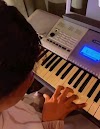### Piano Tutorial: Mastering Arpeggios
#### Understanding Arpeggios
An arpeggio is a musical technique where the notes of a chord are played in sequence rather than simultaneously. This creates a broken chord effect, adding movement and texture to your playing. Arpeggios are commonly used in various styles of music, including classical, jazz, and pop.
#### Basic Arpeggio Patterns
1. **Major Arpeggio**: Consists of the root (1st), major third (3rd), and perfect fifth (5th) of a major chord.
2. **Minor Arpeggio**: Consists of the root (1st), minor third (♭3rd), and perfect fifth (5th) of a minor chord.
3. **Diminished Arpeggio**: Consists of the root (1st), minor third (♭3rd), and diminished fifth (♭5th) of a diminished chord.
4. **Augmented Arpeggio**: Consists of the root (1st), major third (3rd), and augmented fifth (#5th) of an augmented chord.
#### How to Play Arpeggios
1. **Finger Placement**: Assign fingers to each note of the arpeggio, typically using a pattern such as 1-2-3-5 for the right hand and 5-3-2-1 for the left hand.
2. **Hand Position**: Maintain a relaxed hand position and use a slight rotation of the wrist to facilitate smooth movement across the keys.
3. **Practice Slowly**: Start practicing arpeggios slowly and gradually increase the speed as you become more comfortable.
4. **Use a Metronome**: Practice with a metronome to develop a steady rhythm and improve your timing.
#### Practical Examples
Let's apply these principles to play some common arpeggio patterns:
1. **C Major Arpeggio**:
- Right Hand: C-E-G-C-E-G (1-2-3-5-1-2-3)
- Left Hand: C-G-E-C-G-E (5-3-2-1-5-3-2)
2. **A Minor Arpeggio**:
- Right Hand: A-C-E-A-C-E (1-2-3-5-1-2-3)
- Left Hand: A-E-C-A-E-C (5-3-2-1-5-3-2)
3. **F# Diminished Arpeggio**:
- Right Hand: F#-A-C-F#-A-C (1-2-3-5-1-2-3)
- Left Hand: F#-C-A-F#-C-A (5-3-2-1-5-3-2)
Don't forget to share.










0 Comments